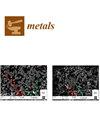电磁场辅助对激光熔覆镍基涂层耐磨性和耐腐蚀性的影响
IF 2.5
3区 材料科学
Q3 MATERIALS SCIENCE, MULTIDISCIPLINARY
引用次数: 0
摘要
由于工作环境恶劣,海上风力发电机通常对关键部件材料提出了更高的要求。因此,本研究引入电磁辅助激光熔覆技术,在风力发电机关键部件材料 Q345R 基体上制备镍基复合涂层。通过扫描电子显微镜 (SEM)、X 射线衍射 (XRD)、能量色散光谱仪 (EDS)、维氏硬度计、摩擦磨损试验机和电化学工作站,分析了不同磁场强度对涂层的宏观形貌、微观结构、相组成、显微硬度、耐磨性和耐腐蚀性的影响。实验结果表明,加入磁场能有效减少表面缺陷,改善表面形貌,且不改变涂层的相组成。随着磁场强度的增加,微观结构逐渐细化,平均显微硬度逐渐增加,在 8 T 时达到最大值 944HV0.5;耐磨性随着磁场强度的增加逐渐增加,特别是当磁场强度达到 12 T 时,与无磁场涂层相比,涂层的磨损率降低了 81.13%,腐蚀电流密度降低了 43.7%。加入电磁场可以提高镍基激光熔覆层的耐磨性和耐腐蚀性。本文章由计算机程序翻译,如有差异,请以英文原文为准。
Effect of Electromagnetic Field Assistance on the Wear and Corrosion Resistance of Nickel-Based Coating by Laser Cladding
Offshore wind turbine generators usually demand higher requirements for key component materials because of the adverse working environment. Therefore, in this study, electromagnetic-assisted laser cladding technology was introduced to prepare the nickel-based composite coating on the Q345R matrix of wind turbine generator key component material. By means of Scanning Electron Microscope (SEM), X-ray diffraction (XRD), Energy Dispersive Spectrometer (EDS), the Vickers hardness tester, friction and wear tester, and electrochemical workstation, the effects of different magnetic field intensities on the macroscopic morphology, microstructure, phase composition, microhardness, wear resistance, and corrosion resistance of the coating were analyzed. The experimental results show that the addition of a magnetic field can effectively reduce the surface defects, improve the surface morphology, and not change the phase composition of the coating. With the increase in magnetic field intensity, the microstructure is gradually refined, and the average microhardness increases gradually, reaching a maximum of 944HV0.5 at 8 T. The wear resistance gradually increases with the increase in magnetic field intensity, especially when the magnetic field intensity reaches 12 T, the wear rate of the coating is reduced by 81.13%, and the corrosion current density is reduced by 43.7% compared with the coating without a magnetic field. The addition of an electromagnetic field can enhance the wear resistance and corrosion resistance of the nickel-based laser cladding layer.
求助全文
通过发布文献求助,成功后即可免费获取论文全文。
去求助
来源期刊

Metals
MATERIALS SCIENCE, MULTIDISCIPLINARY-METALLURGY & METALLURGICAL ENGINEERING
CiteScore
4.90
自引率
13.80%
发文量
1832
审稿时长
1.5 months
期刊介绍:
Metals (ISSN 2075-4701) is an open access journal of related scientific research and technology development. It publishes reviews, regular research papers (articles) and short communications. Our aim is to encourage scientists to publish their experimental and theoretical results in as much detail as possible. Therefore, there is no restriction on the length of the papers. The full experimental details must be provided so that the results can be reproduced. Metals provides a forum for publishing papers which advance the in-depth understanding of the relationship between the structure, the properties or the functions of all kinds of metals.
 求助内容:
求助内容: 应助结果提醒方式:
应助结果提醒方式:


